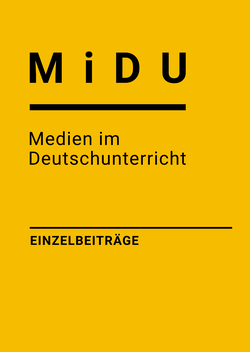Verstehen sichtbar machen – Texterschließung durch digitale Annotations-werkzeuge kollaborativ anbahnen
Datum der Veröffentlichung: 08.11.2021
DOI:
https://doi.org/10.18716/ojs/midu/2021.0.3Schlagwörter:
Digitales Annotieren, Lesestrategien, kollaborative Texterschließung, VOYANT, CATMA, Digital HumanitiesAbstract
In diesem Beitrag wird das Annotieren von Texten als vernachlässigte Praktik des Deutschunterrichts thematisiert. Obwohl die Vermittlung einer Texterschließungskompetenz als ein zentrales Anliegen des Deutschunterrichts betrachtet werden kann, stellt die selbstständige Lektüre von komplexen literarischen Texten und von Sachtexten sowie die Verständigung darüber regelmäßig Schüler:innen vor große Herausforderungen. Das Annotieren soll in diesem Zusammenhang als Lesestrategie verstanden werden, die eine aktive, Fragen entwickelnde und an Taxonomien orientierte kollaborative Auseinandersetzung mit Texten anbahnt. Die beiden im Zentrum des Beitrags stehenden digitalen Tools – Voyant zur Textanalyse und CATMA zum kollaborativen Annotieren – sind Werkzeuge der Digital Humanities. Es wird der Versuch unternommen, diese Arbeitspraktiken auf den Deutschunterricht und konkret auf Franz Kafkas Erzählung Die Verwandlung zu übertragen und als Lesestrategie nutzbar zu machen. Im Beitrag werden die fachwissenschaftlichen und -didaktischen Voraussetzungen, die curricularen Rahmenbedingungen sowie das methodische Setting erläutert, so dass eine schulische Implementierung diskutiert werden kann.
Abstract (english): Visualising Understanding – Initiating Text Analysis collaboratively with Digital Annotation Tools
The subject of this article is the annotation of texts as a neglected practice in German studies. Although the development of text analysis competency can be regarded as a central objective of the curriculum of German studies, autonomous reading of complex literary and non-literary texts as well as communicating about them poses major challenges to learners. In this context, annotation is to be understood as a reading strategy initiating active collaborative text analysis that encourages questioning and the use of analytical concepts. The two digital tools at the centre of this article – Voyant for text analysis and CATMA for collaborative annotation – are tools used in Digital Humanities. An attempt is made here to transfer these methods to the classroom and more specifically to Kafka’s The Metamorphosis (Die Verwandlung), and to apply them as reading strategies. The article describes the premises inherent in the subject as well as the didactics of German teaching, the curricular framework as well as the methodological setting in order to discuss its implementation in the classroom.
Downloads
Veröffentlicht
Versionen
- 08.11.2021 (4)
- 08.11.2021 (3)
- 08.11.2021 (2)
- 08.11.2021 (1)







